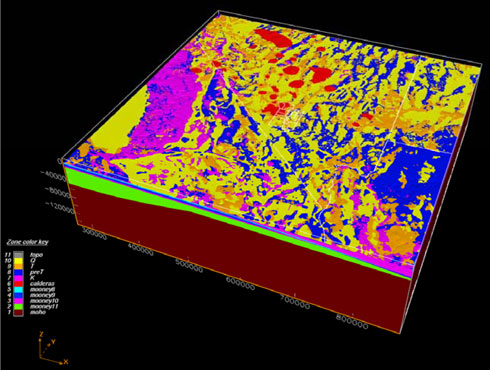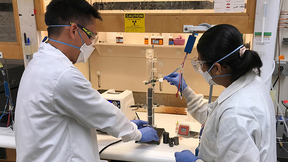Funds injected into carbon sequestration effort
 (Download Image)
A geomodel of southwestern U.S. region that includes wave propagation modeling.
(Download Image)
A geomodel of southwestern U.S. region that includes wave propagation modeling.
The Laboratory has received $3 million in American Recovery and Reinvestment Act dollars to capture and transport 1 million tons of carbon dioxide from Bay Area power plants and inject it more than two miles underground.
Laboratory researchers will collaborate with Lawrence Berkeley and C6 Resources, a Shell Oil Company affiliate, on the carbon sequestration project.
The goal of the LLNL project is to capture carbon dioxide at its source, preferably coal burning power plants, and transport it via a pipeline to the Central Valley where it will be injected two miles underground into a saline formation.
The Lab project is one of 12 projects that last week received $21.6 million in ARRA funds from Energy Secretary Steven Chu.
LLNL principal investigator Elizabeth Burton said LLNL will address the risk elements of the project including assessing seismic hazards in the area and from there, build a regional geological model. The model will support large-scale pressure response and brine migration simulations, which will be performed by LBNL.
"This project provides the Laboratory with an opportunity to test and transfer decision-making tools in support of the ARRA's objectives of greenhouse gas reduction," Burton said. "Our overreaching goal is to deploy carbon capture and sequestration (CCS) safely as a greenhouse gas emissions reduction technology."
Lab researchers will be able to provide important information to support permitting of the project and to address public concerns about the seismic safety of such a project in California.
This work builds on similar efforts by LLNL in support of the West Coast Regional Carbon Sequestration Partnership (WESTCARB) Phase III injection site. WESTCARB is a collaborative research project bringing scientists and engineers together from more than 80 public agencies, private companies, and nonprofits to identify and validate the best regional opportunities for keeping CO 2 out of the atmosphere.
WESTCARB is one of seven research partnerships co-funded by the Department of Energy to characterize regional carbon sequestration opportunities and conduct technology validation field tests.
"The California project provides LLNL with an opportunity to vet these tools at a second site and in a very different geologic setting," Burton said.
During Phase I, Lab scientists will collect data and assess the potential seismic scenarios and modify LLNL's wave propagation codes to address other risks. In Phase 2, LLNL will develop the geomodel and make the model available for risk assessment efforts by LLNL and other project partners.
The Laboratory has been an active partner in several of DOE's regional carbon sequestration partnerships. In particular, LLNL scientists also participate in several CCS projects internationally, including In Salah and Weyburn. LLNL has strong expertise in the subsurface elements of geologic carbon storage, including site characterization, monitoring, verification and accounting, geomechanical and geochemical impacts and in simulation and risk assessment.
In addition, LLNL has extensive experience in developing regional 3D geomodels for CCS using some of the Lab's largest supercomputers.
"To create a model of this size, LLNL will leverage work done close to the site by the project developer, but also the 3-D models generated for the Bay Area by the USGS, the Laboratory and others," said Julio Friedmann, head of the Lab's Carbon Management Program.
Information that will be included in the model will include boreholes from the oil and gas industry and geologic information in the Montezuma Hills area (a small range of low-elevation hills at the northern banks of the Sacramento River Delta in Solano County) from developed oil and gas fields and wildcat exploration wells drilled prior to 1980.
Friedmann said the Laboratory has extensive experience in the regulatory and public perception issues associated with CCS, and have worked with policymakers, regulators, and other stakeholders at the national and state levels on these issues.
"This project is an opportunity for us to show the nation that carbon sequestration can work at a regional level," he said.
Contact
Anne M. Stark[email protected]
Related Links
Locked in rock sequestering carbon dioxide undergroundLivermore Lab and American Shale Oil team to study carbon sequestration
Carbon goes full circle in the Amazon
BP and LLNL sign technical cooperation agreement on underground coal gasification
Fire in the hole
Tags
Earth and Atmospheric ScienceSequestration
Featured Articles







